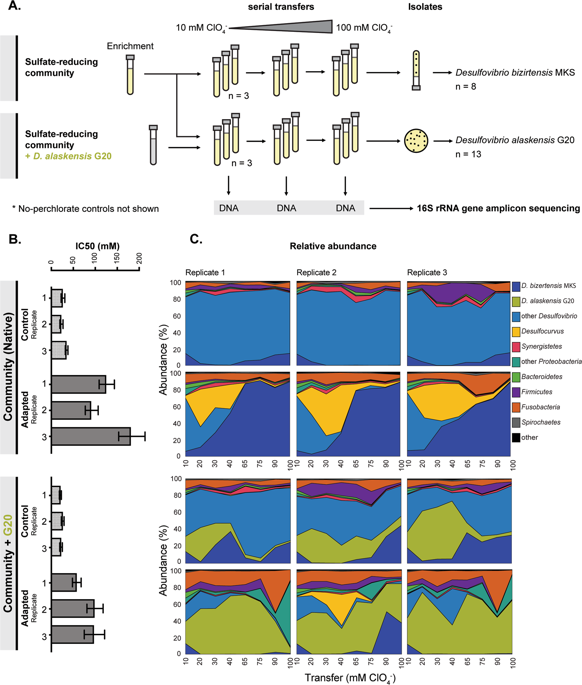Our official English website, www.x-mol.net, welcomes your feedback! (Note: you will need to create a separate account there.)
Anion transport as a target of adaption to perchlorate in sulfate-reducing communities.
The ISME Journal ( IF 11.0 ) Pub Date : 2019-10-28 , DOI: 10.1038/s41396-019-0540-7 Magdalena K Stoeva 1, 2 , Jennifer Kuehl 3, 4 , Alexey E Kazakov 3 , Ouwei Wang 1, 2 , Rowena Rushton-Green 1, 5 , John D Coates 1, 2, 3
The ISME Journal ( IF 11.0 ) Pub Date : 2019-10-28 , DOI: 10.1038/s41396-019-0540-7 Magdalena K Stoeva 1, 2 , Jennifer Kuehl 3, 4 , Alexey E Kazakov 3 , Ouwei Wang 1, 2 , Rowena Rushton-Green 1, 5 , John D Coates 1, 2, 3
Affiliation

|
Inhibitors can be used to control the functionality of microbial communities by targeting specific metabolisms. The targeted inhibition of dissimilatory sulfate reduction limits the generation of toxic and corrosive hydrogen sulfide across several industrial systems. Sulfate-reducing microorganisms (SRM) are specifically inhibited by sulfate analogs, such as perchlorate. Previously, we showed pure culture SRM adaptation to perchlorate stress through mutation of the sulfate adenylyltransferase, a central enzyme in the sulfate reduction pathway. Here, we explored adaptation to perchlorate across unconstrained SRM on a community scale. We followed natural and bio-augmented sulfidogenic communities through serial transfers in increasing concentrations of perchlorate. Our results demonstrated that perchlorate stress altered community structure by initially selecting for innately more resistant strains. Isolation, whole-genome sequencing, and molecular biology techniques allowed us to define subsequent genetic mechanisms of adaptation that arose across the dominant adapting SRM. Changes in the regulation of divalent anion:sodium symporter family transporters led to increased intracellular sulfate to perchlorate ratios, allowing SRM to escape the effects of competitive inhibition. Thus, in contrast to pure-culture results, SRM in communities cope with perchlorate stress via changes in anion transport and its regulation. This highlights the value of probing evolutionary questions in an ecological framework, bridging the gap between ecology, evolution, genomics, and physiology.
中文翻译:

阴离子转运作为适应硫酸盐还原群落中高氯酸盐的目标。
抑制剂可用于通过靶向特定代谢来控制微生物群落的功能。对异化硫酸盐还原的针对性抑制限制了多个工业系统中有毒和腐蚀性硫化氢的产生。硫酸盐还原微生物 (SRM) 受到硫酸盐类似物(如高氯酸盐)的特异性抑制。以前,我们通过硫酸腺苷酸转移酶(硫酸盐还原途径中的中心酶)的突变展示了纯培养 SRM 对高氯酸盐胁迫的适应。在这里,我们探索了在社区规模上跨不受约束的 SRM 对高氯酸盐的适应。我们通过增加高氯酸盐浓度的连续转移来跟踪自然和生物增强的硫化群落。我们的研究结果表明,高氯酸盐胁迫通过最初选择天生更具抗性的菌株来改变群落结构。分离、全基因组测序和分子生物学技术使我们能够定义在主要适应 SRM 中出现的后续适应遗传机制。二价阴离子调节的变化:钠同向转运体家族转运蛋白导致细胞内硫酸盐与高氯酸盐的比率增加,从而使 SRM 能够逃避竞争性抑制的影响。因此,与纯培养结果相比,社区中的 SRM 通过阴离子转运及其调节的变化来应对高氯酸盐胁迫。这突出了在生态框架中探索进化问题的价值,弥合了生态、进化、基因组学和生理学之间的差距。
更新日期:2020-01-17
中文翻译:

阴离子转运作为适应硫酸盐还原群落中高氯酸盐的目标。
抑制剂可用于通过靶向特定代谢来控制微生物群落的功能。对异化硫酸盐还原的针对性抑制限制了多个工业系统中有毒和腐蚀性硫化氢的产生。硫酸盐还原微生物 (SRM) 受到硫酸盐类似物(如高氯酸盐)的特异性抑制。以前,我们通过硫酸腺苷酸转移酶(硫酸盐还原途径中的中心酶)的突变展示了纯培养 SRM 对高氯酸盐胁迫的适应。在这里,我们探索了在社区规模上跨不受约束的 SRM 对高氯酸盐的适应。我们通过增加高氯酸盐浓度的连续转移来跟踪自然和生物增强的硫化群落。我们的研究结果表明,高氯酸盐胁迫通过最初选择天生更具抗性的菌株来改变群落结构。分离、全基因组测序和分子生物学技术使我们能够定义在主要适应 SRM 中出现的后续适应遗传机制。二价阴离子调节的变化:钠同向转运体家族转运蛋白导致细胞内硫酸盐与高氯酸盐的比率增加,从而使 SRM 能够逃避竞争性抑制的影响。因此,与纯培养结果相比,社区中的 SRM 通过阴离子转运及其调节的变化来应对高氯酸盐胁迫。这突出了在生态框架中探索进化问题的价值,弥合了生态、进化、基因组学和生理学之间的差距。



























 京公网安备 11010802027423号
京公网安备 11010802027423号